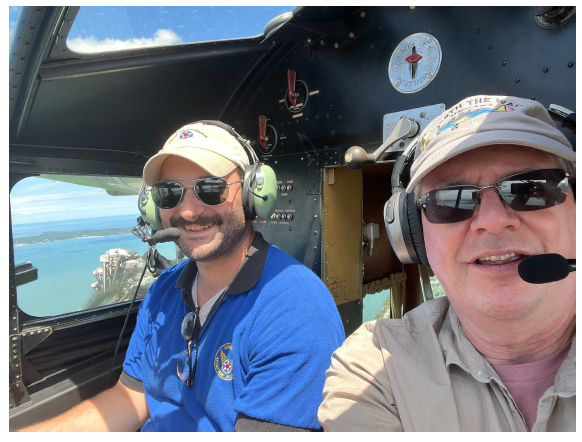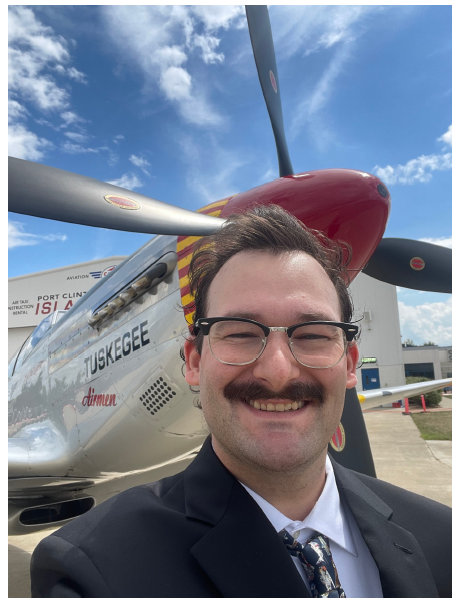Join us as we hear from last year’s public history interns! Graduate students in history at BGSU completed internships across the state in 2024. Today, we’ll read about Patrick Cook’s experience working for the Liberty Aviation Museum in Port Clinton, Ohio.

The following reflection was written by Patrick Cook and has been lightly edited.
As the museum’s Education Coordinator, I create advertisements and flyers for my educational programming at Liberty Aviation Museum. Much of my passive advertisements can be found on the museum’s website, and many of my flyers can be found at the desks around the museum. My most prominent role at the museum is as a tour guide and leader. Commonly, I have school tours meet me at the front desk after they depart their bus. I take this time to center people on the tour I am about to give, asking them if they have ever been to the museum before or know what a “working museum” is. Then it’s off and running through our local history section. I begin with local legend Milton Hersberger and the history of Island Airlines. Showcasing what life was like for the people who relied on Island Airlines and what service to the islands in a Ford Tri-Motor was like, I also discuss Dr. Roy Evans, the doctor for Put-in-Bay during the mid-20th century and an avid ice fisherman. Following Dr. Evans, we discuss another local legend, Harold Haucks, who ran “Island AIrlines” following Milton Hersberger’s retirement. Following the local history section, we finally enter our hangar space where students get familiar with the Ford Tri-Motor and, if time permitting, can enter into the Ford Trim-Motor alongside me where we discuss the Ford Tri-Motor, and Transcontinental Air Transport, the first major Airline in the United States. Following their tour of the Ford, we embark back to the second building, which houses a majority of our World War II collection, including our M5A3 E8 “Easy 8” Sherman, our Vosper Pt-Boat restoration project, our B-25 Mitchell, and countless out airplanes, vehicles and restoration projects. By the end, students’ interest often started to wane, and I know for certain that I had done my job with the students, marking another successful tour.
Some days are dull and mundane, such as answering calls and emails or attending meetings. However, most of my days are filled with enjoyable tasks, either preparing an exhibit alongside the Museum Archivist or assisting in moving or operating some of our aircraft, such as the B-25 Mitchell or 1928 Ford Tri-Motor. The B-25 Mitchell aircraft has recently undergone an overhaul on its right engine, which requires some troubleshooting, and has not flown for nearly 6 months. However, museum management and I are eager to see it fly again. I have also assisted in operating the 1928 Ford Tri-Motor on its living history rides when our organization can give weekend rides, weather permitting. When our aircraft was operating, I was often a ticket operator and a ground crew member.

My duties commonly include chocking the aircraft (placing blocks in front and behind its landing gear so that it does not move) when it loads and unloads passengers, signaling the pilot to start each engine, and ensuring the engine is started correctly. I also operate as a ground crew member when our museum hosts the Army Aviation Heritage group. I commonly assist in cold and hot loading of passengers on board the vintage UH-1 Huey Helicopter—cold and hot loading notes whether the engine and blades are running. Yet, one of my greatest pleasures at the museum is thanks to my training as a private pilot. Yet, one of my greatest pleasures at the museum is thanks to my training as a private pilot. When the stars aligned, I got to co-pilot our Ford Tri-Motor aircraft, which has been the experience of a lifetime and left me grinning ear to ear. Flying such a vintage aircraft has always been on my bucket list, and flying such a famous aircraft was indeed a gift.
My almost three years of museum management have taught me many things, but my biggest takeaway is my enjoyment of what I do on a day-to-day basis. One of the most significant challenges at Liberty Aviation Museum is its location. Port Clinton is about an hour’s drive outside Toledo and an hour and a half outside Cleveland. Overall, my time at Liberty Aviation Museum has been overwhelmingly positive. I cannot think of any more excellent way to continue my career as a museum’s management team member. These experiences will undoubtedly follow me throughout my career. I cannot thank Liberty Aviation Museum enough for the opportunities it has given me over the last year and a half. The experiences and skills I’ve gained at the museum will follow me throughout my career. Although I will miss being around the working aircraft and collection, I am eager and excited to see what opportunities await post-graduation.
